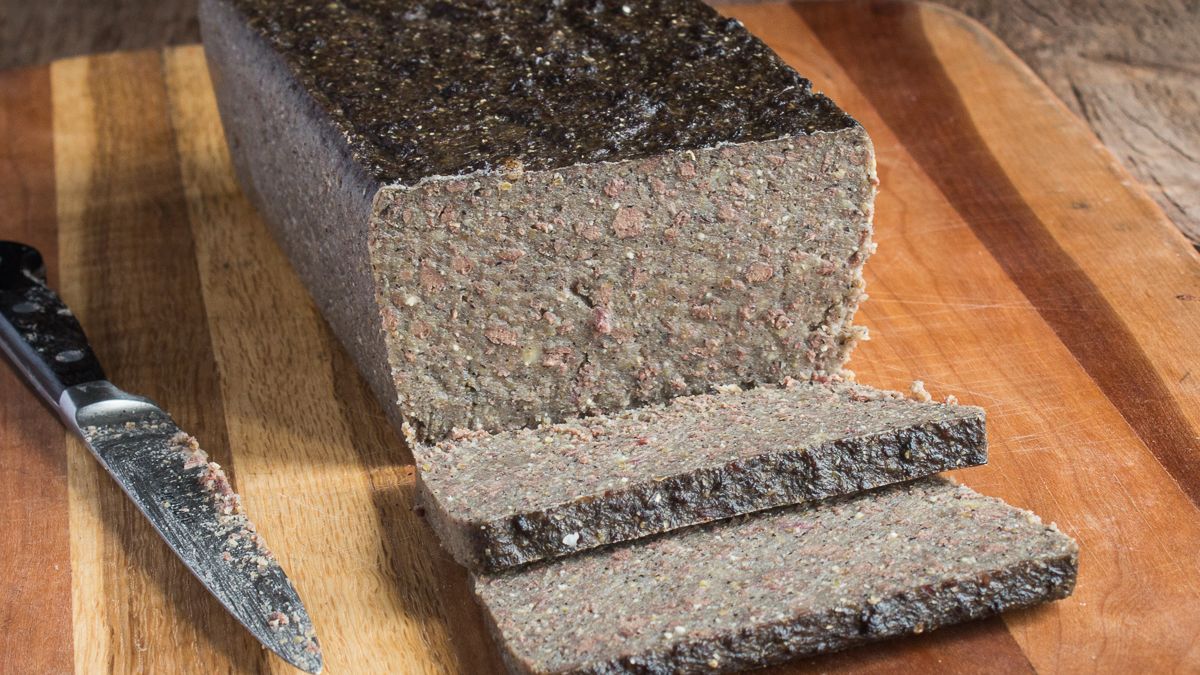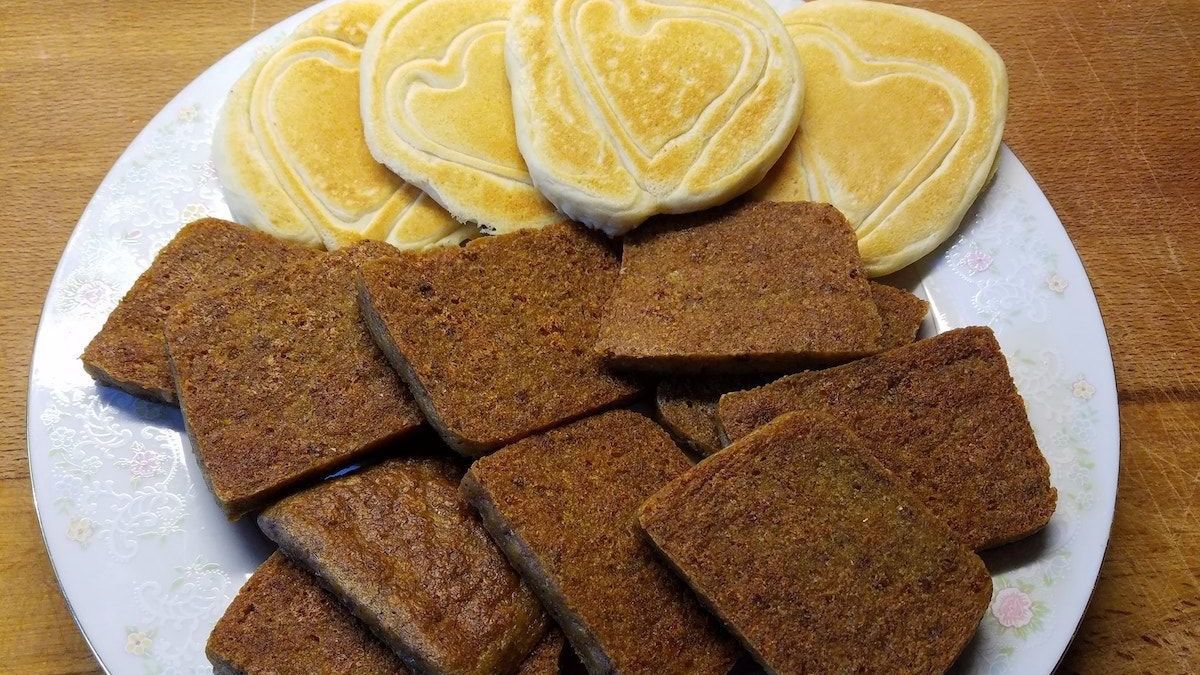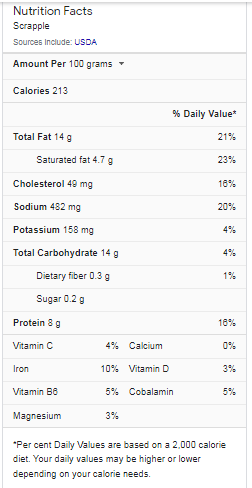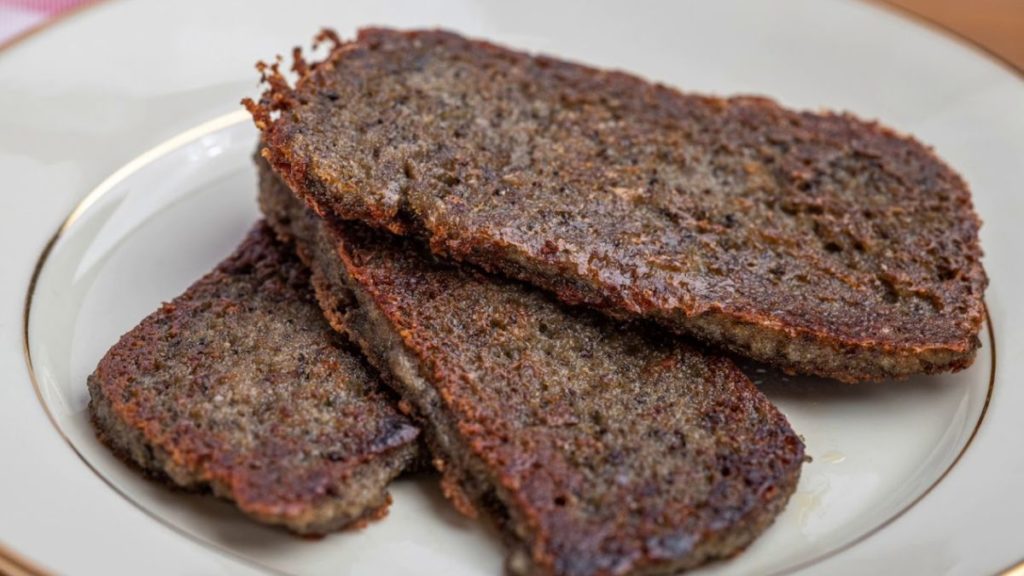Scrapple is a breakfast meat product traditionally eaten in parts of Pennsylvania and the Mid-Atlantic. German immigrants, now known as the Pennsylvania Dutch, brought this economic dish to the region in the 17th and 18th centuries. Leftover pork cuts are blended with flour or cornmeal to make a cheap, filling source of protein that lets no scrap of meat go to waste.
Depending on what you put in it, scrapple can taste like liverwurst or French country paté. Some scrapple is made without liver, and they can taste like breakfast sausage depending on how much sage is in the recipe. Scrapple is a kind of meat pudding. It is usually made with finely chopped pork meat and offal, spices, and coarse flour-like cornmeal or buckwheat.
Scrapple Nutrition Facts
What is Scrapple?
It uses every part of the pig, from the meat to the skin to the organs like the liver and tongue. These scraps are finely ground and mixed with pork stock and binders like wheat flour, buckwheat flour, or cornmeal. They are then seasoned with salt and a mix of spices that varies from producer to producer. The result is a loaf that keeps its shape when cut. When fried in a pan, the outside gets crispy and caramelized, while the inside stays soft and warm.
In Pennsylvania, restaurants and grocery stores always have scrapple on the menu. You can find it on breakfast sandwiches at street food carts, with eggs and home fries at diners, and cubed, fried, and speared on a deer antler at high-end restaurants like Elwood, a BYOB in Philadelphia’s fish town neighborhood that focuses on local food and drinks.
It is a dish made from pork scraps, usually trimmings, cornmeal, and spices. Each ingredient is cooked on its own, and all of them are put together in a loaf pan to cool. Once the loaf is done, it is cut into pieces and served. It’s helpful to compare this to pate, which also uses bits and pieces that have been left over. Pennsylvania Dutch settlers made scrapple from what they had on hand, hogs, and corn, and made something magical. Scrapple is often called liver mush in the South.
How to Cook Scrapple?
Cut the scrapple into half-inch-thick slices, and then roll both sides in flour that has been seasoned with salt and pepper. Shake or brush the bread slices to remove any extra flour on the top.
Some oil or bacon grease should be heated in a pan over medium-high heat. Put the scrapple slices in the pan and cook for three to five minutes on each side until they are browned and crisp. Place the finished slices on a paper towel-lined plate to drain, and serve immediately. The best way to make a crispy crust on scrapple is to fry it in a pan, but you can also bake it. Put the slices on a baking sheet and bake at 375 F for 40 minutes. Use a spatula to flip the slices over and crisp up the other side halfway through the baking time.
Since it is already cooked when you buy it, you don’t have to cook it for health or safety reasons. But most people pan-fry it to warm it up and make it crispier. If you have a loaf, cut it into 1/2 to 3/4 inches thick pieces and fry them in butter, oil, or lard until both sides are golden brown.
What does Scrapple Taste Like?
The caramelized cornmeal or flour mixed into the meat gives scrapple a rich, savory flavor with a hint of toast. On the outside, it has a crunchy texture, while the inside is soft and tender. Scrapple will also taste like any spices used to flavor it, like allspice, cloves, nutmeg, onion, garlic, and black pepper. Depending on what you put in it, scrapple can taste like liverwurst or French country paté. Some scrapple is made without liver, and they can taste like breakfast sausage depending on how much sage is in the recipe.
Scrapple vs. Goetta vs. Livermush
German immigrants didn’t just come up with scrapple as a way to stretch meat supplies in their area. In the area around Cincinnati, Ohio, similar cuts of pork are mixed with steel-cut oats, onions, and spices, then cooked and shaped into loaves. After that, the meat is shaped into patties that look like sausages and fried. Goetta can be eaten for breakfast, a sandwich, burger, or even a pizza.
A similar dish, livermush, is served in the western part of North Carolina and neighboring states like Virginia and South Carolina. It is made by grinding pork liver and other scraps and mixing them with cornmeal. It is similar to scrapple, but the liver is the main source of meat, and there is more cornmeal than scrapple. Spices like black pepper and sage are often used to make livermush taste like breakfast sausage. It is sliced and fried, like scrapple, and is usually eaten for breakfast.
In the Netherlands, scraps of pork from the head are mixed with buckwheat flour and herbs to make a traditional dish called balkenbrij. This tastes a lot like scrapple.
What is it Made of?
Cooked pork scraps and cornmeal are used to make scrapple. It has bay leaves, peppercorns, thyme, sage, garlic, and salt to give it flavor. People avoid scrapple because they don’t know what’s in it. It is made with organ parts like hearts, livers, tongues, tails, and skin, as well as the ends of pork loins and tips of pork ribs. Don’t forget that these parts are also used to make pate.
When the pork scraps and bones are cooked together, they make a rich broth. The fat and tough parts are taken out when the pork is cooked, and the rest of the meat is put through a grinder. The broth is used for cooking the cornmeal, resulting in polenta with some cooked pork mixed in. Some recipes call for a few tablespoons of wheat flour or buckwheat flour.
Why Should you Try Scrapple?
This article should have given you a lot of information about scrapple. If you’re still undecided about trying this unique breakfast meal, here are five strong reasons.
It’s a regional favorite: In a country as big and varied as the United States, each region has special foods that make people proud and spread to other parts of the country. These include specialties like Carolina barbecue or Cajun food and dishes like Cincinnati chili or Chicago deep-dish pizza. If you like to eat your way through the different parts of America, you must try scrapple. It is a unique dish to Pennsylvania and will take your taste buds there.
It’s hearty and nutritious: Another reason to try scrapple is that it’s filling enough to help you get a good start to the day. Organ meat is a great source of vitamins and minerals, but many Americans don’t eat it very often. You get a healthy breakfast when you mix pork with offal, which is full of nutrients, and healthy grains.
Some Additional Factors
It’s a great way to switch up breakfast: Most of the time, you have to choose between bacon and sausage for breakfast. At S. C de Weaver, we’ve been giving these tasty breakfast meats to families for a hundred years. But we also think that scrapple is a great way to make breakfasts more interesting.
There are so many ways to enjoy it: Because scrapple is versatile, you can serve it in many different ways. Even if you try and don’t love it, you might love it cooked differently. If it’s love at first bite, you can still try it with different toppings and sides to enjoy it in different ways.
It’s delicious: Lastly, try scrapple because it tastes good, and there m st be a reason why it has lasted so long. People love this pork product’s unique texture and flavor. Scrapple reminds many Pennsylvanians of home, and it tastes great.
Where to Buy it?
Blocks of scrapple can be found in well-stocked grocery stores, supermarkets, butcher shops, and food co-ops’ breakfast meat sections. Most of the time, it comes in square or rectangular loaves vacuum-sealed in plastic. Scrapple can also be found frozen in the freezer aisle and sometimes at farmers’ markets, especially in Pennsylvania, Delaware, and Maryland.
Storing Scrapple
Keep scrapple in the fridge in the package it came in. If it’s frozen, put it in the freezer and let it thaw in the fridge (or follow the directions on the package) the night before you want to use it. After it’s been opened, put the uncooked scrapple in a plastic bag or container that won’t let air in and put it in the fridge.
The USDA says that scrapple can usually be kept in the fridge for up to 50 days. Check t e best-by date on the package to be sure. You can keep scrapple in your freezer for up to a year if it is frozen.
How do you Eat Scrapple?
To make scrapple taste good, add the correct toppings or eat it with other breakfast items. People like to get creative with scrapple because it can be used in many different ways. Let’s t take a closer look at how you can cook scrapple.
On a breakfast sandwich: After lightly frying scrapple slices in a skillet, you can serve them with other breakfast favorites like fried eggs and potatoes. Some people like to put scrapple between an egg and melted cheese or two halves of a bagel to make a breakfast sandwich.
With sweet condiments: You can add a little sweetness to the savory scrapple by eating it with apple butter, honey, jelly, or maple syrup. This sweet-salty combination is delicious if you’ve had maple bacon or maple sausage for breakfast.
Some Additional Factors
With savory condiments: People also like to put savory condiments on top of a tasty slice of scrapple. You can try ketchup, horseradish, or mustard, among other things. Try dif aren’t things to see what goes well with your scrapple. There an e a lot of options.
As a dinner entree: Even though scrapple is usually eaten for breakfast, there are no rules that say you can only eat it for breakfast. You can also serve it like meatloaf as the main dish. With so e sides of vegetables, it makes a tasty and comforting dinner.
As a snack: Because it is filling and healthy, it can also be eaten as a snack between meals when you need a pick-me-up. Try to eat a slice of scrapple with some cut-up fruit or applesauce. Most of the time, these flavors go well together, giving you the energy you need to get through the day until your next meal.
Conclusion
It has a lot of carbohydrates, protein, Vitamin A, and iron. It also has a lot of saturated fat, fat, and sodium. 2 The n nutrition information for scrapple depends on who makes it. Usually, scrapple is served for breakfast along with eggs, pancakes, potatoes, toast, and sometimes ketchup. It can be used to make sandwiches, and they could also be served as an appetizer on top of crackers.



